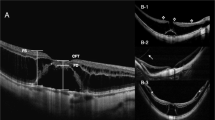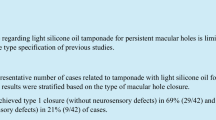Abstract
Background
To evaluate the efficacy of long-term gas tamponade after pars plana vitrectomy (PPV) for retinal detachment (RD) due to a macular hole (MH) in highly myopic eyes.
Methods
A retrospective study was conducted at two institutions. The study included 25 highly myopic eyes with RD resulting from a MH. C3F8 gas tamponade was used in 13 eyes (C3F8 gas group), and SF6 gas tamponade was used in 12 eyes (SF6 gas group) following PPV. C3F8 gas has a longer half-life time in the vitreous cavity than SF6 gas. The main outcome measures were the anatomic reattachment rate and the visual acuity (VA). Follow-up periods were at least 24 months.
Results
The anatomic reattachment rate and MH closure following the initial surgery were significantly higher in the C3F8 gas group (100%) than in the SF6 gas group (66.7%; P=0.039). The differences in the postoperative VAs were not significant both for all eyes and only for eyes with initial anatomic success. (P=0.42 and P=0.54, respectively). In addition, no significant difference was found in the improvement of VA both for all eyes and for the initial success eyes (P=0.66 and P=0.56, respectively).
Conclusion
We conclude that the longer duration of tamponade with C3F8 gas results in a higher rate of successful closure and that C3F8 gas tamponade is an effective treatment for MH with RD in highly myopic eyes.

Similar content being viewed by others
References
Aaberg TM, Blair CJ, Gass JDM (1970) Macular holes. Am J Ophthalmol 65:555–561
Blankenship GW, Ibanez-Langlois S (1987) Treatment of myopic macular hole and retinal detachment. Ophthalmology 94:333–336
Enaida H, SakamotoT, Hisatomi T, Goto Y, Ishibashi T (2002) Morphological and functional damage of the retina caused by intravitreous indocyanine green in rat eyes. Graefes Arch Clin Exp Ophthalmol 240:209–213
Gandorfer A, Haritoglou C, Gass CA, Ulbig MW, Kampik A (2001) Indocyanine green-assisted peeling of the internal limiting membrane may cause retinal damage. Am J Ophthalmol 132:431–433
Gandorfer A, Haritoglou C, Gandorfer A, Kampik A (2003) Retinal damage from ICG in experimental macular surgery. Invest Ophthalmol Vis Sci 44:316–323
Gonvers M, Machemer R (1982) A new approach to treating retinal detachment with macular holes. Am J Ophthalmol 94:468–472
Haritoglou C, Gandorfer A, Gass CA, Schaumberger M, Ulbig MW, Kampik A (2002) Indocyanine-green assisted peeling of the internal limiting membrane in macular hole surgery affects visual outcome: a clinicopathologic correlation. Am J Ophthalmol 134:836–841
Ishida S, Yamazaki K, Shinoda K, Kawashima S, Oguchi Y (2000) Macular hole retinal detachment in highly myopic eyes. Ultrastructure of surgically removed epiretinal membrane and clinicopathologic correlation. Retina 20:176–183
Kadonosono K, Yazama F, Itoh N, Uchio E, Nakamura S, Akura J, Sawada H, Ohno S (2001) Treatment of retinal detachment resulting from myopic macular hole with internal limiting membrane removal. Am J Ophthalmol 131:203–207
Leaver PK, Cleary PE. (1975) Macular hole and retinal detachment. Trans Ophthalmol Soc UK 95:145–147
Lewis JM, Park I, Ohji M, Saito Y, Tano Y (1997) Diamond-dusted silicone cannula for epiretinal membrane separation during vitreous surgery. Am J Ophthalmol 124:552–554
Marmor MF (1994) Mechanisms of normal retinal adhesion. In: Ryan SJ, Glaser BM (eds) Retina, 2nd edn. Mosby Year Book, St. Louis, pp 1931–1953
Miyake Y (1986) A simplified method of treating retinal detachment with macular hole: long-term follow-up. Arch Ophthalmol 104:1234–1236
Oshima Y, Ikuno Y, Motokura M, Nakae K, Tano Y (1998) Complete epiretinal membrane separation in highly myopic eyes with retinal detachment resulting from a macular hole. Am J Ophthalmol 126:669–676
Seike C, Kusaka S, Sakagami K, Ohashi Y (1997) Reopening of macular holes in highly myopic eyes with retinal detachments. Retina 17:2–6
Sippy BD, Engelbrecht NE, Hubbard GB, Shunai Jiang SEM, Aaberg TM Jr, Aaberg TM Sr, Grossniklaus HE, Sternberg P Jr (2001) Indocyanine green effect on cultured human retinal pigment epithelial cells: implication for macular hole surgery. Am J Ophthalmol 132:433–435
Stripe M, Michels RG (1990) Retinal detachment in highly myopic eyes due to macular holes and epiretinal traction. Retina 10:113–114
Tamura T, Saito A, Miyake Y (1989) The retinal detachment due to macular hole after removal of macular buckling. Jpn Rev Clin Ophthalmol 83:1521–1523
Terasaki H, Miyake Y, Nomura R, Piao CH, Hori K, Niwa T, Kondo M (2001) Focal macular ERGs in eyes after removal of macular ILM during macular hole surgery. Invest Ophthalmol Vis Sci 42:229–234
Tornambe PE, Poliner LS, Cohen RG (1998) Definition of macular hole surgery end points: Elevated/Open, Flat/Open, Flat/Closed. Retina 18:286–287
Wolfensberger TJ, Gonvers M (1988) Long-term follow-up retinal detachment due to macular hole in myopic eyes treated by temporary silicone oil tamponade and laser photocoagulation. Ophthalmology 95:917–924
Author information
Authors and Affiliations
Corresponding author
Additional information
None of the authors or their family members has any proprietary or financial interest in the instruments used in this study.
Rights and permissions
About this article
Cite this article
Uemoto, R., Saito, Y., Sato, S. et al. Better success of retinal reattachment with long-standing gas tamponade in highly myopic eyes. Graefe's Arch Clin Exp Ophthalmol 241, 792–796 (2003). https://doi.org/10.1007/s00417-003-0750-5
Received:
Revised:
Accepted:
Published:
Issue Date:
DOI: https://doi.org/10.1007/s00417-003-0750-5




